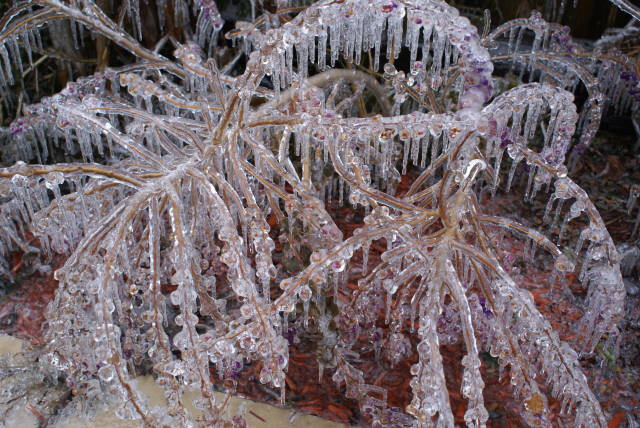Every year, severe ice storms occur in the United States and Canada. They are especially prevalent in the midwestern and eastern United States. In these regions, ice storms act as a major natural disturbance, and are capable of devastating trees in urban and deciduous forests.
How Ice Storms Form
Ice storms, also referred to as glaze storms, are defined as the accumulation of at least ¼ inch of ice on an exposed surface. They occur from October to early April, peaking in frequency between December and March. Ice storms are influenced by general weather patterns. They develop when a winter warm front passes through an area after the ground level temperature has reached or fallen below freezing. When this occurs, rain falls from a warm layer of air before passing through many layers of cooler air. The rain continues its descent without freezing, eventually becoming supercooled. Ice accumulates when supercooled rain makes contact with an exposed surface that is at or below the freezing point.
Impact on Trees
Ice accumulation generally contributes up to an inch in additional stem diameter. In rarer cases, accumulations of up to eight inches have been reported. Ice accumulation can increase the branch weight of trees by ten to one hundred times. Accumulations of ¼ inch to ½ inch can cause small branches and weak limbs to break. Accumulations of ½ inch to an inch or greater can result in fractures or breakages in larger branches. Branch failure occurs when the weight of the ice exceeds wood resistance, or the additional loading stresses an already weakened area in the branch.
Prevention and Management
When planting, consider tree species that are resistant to ice storms, especially in regions where ice storms occur with greater frequency. Selecting ice resistant species can help reduce the potential of tree and property damage resulting from ice storms. Species that form broad crowns, and are genetically prone to included bark or decurrent branching patterns are more susceptible to ice storms. Species that form excurrent branching patterns, and are not prone to included bark or other structural weaknesses are more resistant. Trees should be planted safely away from buildings and other structures, including above-ground utilities and power lines.
Regular tree maintenance should be performed on all trees. This ensures the removal of structurally weak branches, while also maintaining proper crown growth, reducing the surface area of lateral branches, and decreasing wind resistance. Avoid using hazardous pruning techniques, such as flush-cut pruning or tree topping. These are harmful to trees, and can place them in a weakened state, leading to greater ice storm susceptibility. Trees that are pruned from a young age tend to have a greater resistance to ice storms than those that are not.
When a tree or branch is wounded, and must be stabilized, the installation of a cable or brace can increase the tree’s tolerance to ice accumulation.
Trees that exhibit signs of decay, or have developed large cavities in their trunk should be promptly removed.
Photo courtesy of Beverly Reese, NOAA.


